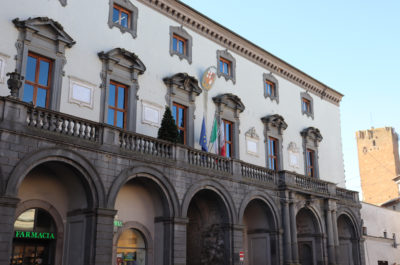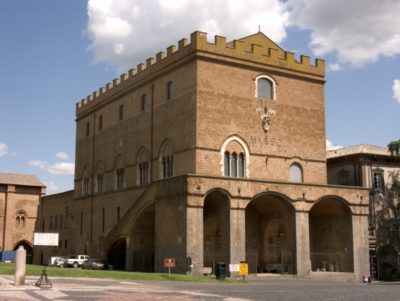Here are some of the most beautiful and famous historic palaces in the city of Orvieto. In addition to the medieval most important palaces (Palazzo Comunale, Palazzo del Popolo, Palazzo Soliano and Palazzo dei Sette) there are many other elegant historic buildings all along the city center: from the Middle Age to Renaissance period who belonged to the Pope or local noble families (which often gave there name to the palaces).
Important palaces of the Medieval period:
 Palazzo Comunale
Palazzo Comunale
Located in Piazza della Repubblica, adjacent to the church of St. Andrea, the handsome headquarters building of the Municipality of Orvieto is originally an old building (probably dating back to the twelfth century) and has been enlarged and restored over time; the last intervention dates back to 1600, at the hands of Ippolito Scalza (famous local architect and sculptor).
After being passed from noble families to the local church it has returned to its original directive occupied by the city to this day, although most of the offices were transferred to the building of the former infirmary barracks Piave. The Town Hall is well proportioned and elegant appearance and has the base of the arches that support a fine row of balconies.
 Palazzo Soliano
Palazzo Soliano
The palace is located in Piazza Duomo, next to the cathedral. Its construction, dated 1297, was conceived to sanction a phase of reconciliation between the Pope Bonifacio VIII and the Municipality of Orvieto after which the two parts lived a period of strong tensions tied to the control of some territories of the high Lazio. The construction of this elegant building (in the Middle Ages called the “Palazzone”) represented the most evident symbol of a rediscovered peace and harmony between the Pope and the city of Orvieto. To further testify to this, in addition to the palace, the pontiff was honored with the placement of two statues dedicated to him on the niches located above the main city gates: Porta Soliana and Porta Maggiore. Today this palace hosts at the ground floor the modern art museum Emilio Greco (with an exhibition of statues and paintings) and the ticket offices of the Duomo.
 Palazzo dei Sette
Palazzo dei Sette
This palace belongs to the Middle Ages, it is set just next to the Torre del Moro and was named in medieval times because it housed the seven judges who represented the major corporations and trades of Orvieto.
Then the palace became also a residential place for the Pope and then again the house of Antonio da Sangallo (the famous architect who projected the Saint Patrick well).
Actually, this modernized palace, is a great place to host local events and art- exhibitions.
Other important Orvieto’s palaces of the Renaissance period:
Palazzo Buzi: One of the buildings designed by the Orvieto architect Ipolito Scalza, was built around 1580 and is located on the road that connects Piazza Marconi to Piazza del Duomo.
Palazzo Ottaviani : A fine show in the great Piazza della Repubblica, today the historic headquarters of a local bank. At one time it housed Locanda delle Belle Arti, and Garibaldi stayed there once. It has high quality interiors and wooden coffered ceilings.
Palazzo Crispo Marsciano: Overlooking Piazza Marconi designed by Antonio da Sangallo, this palace has an imposing facade and is adjacent to the church of San Bernardino.
Palazzo Clementini : Started by Ipolito Scalza in 1567, but was left unfinished until 1937, when Gustavo Giovannoni completed it. Today is AEDE of the grammar school of Orvieto.
Palazzo dell’Opera del Duomo: Built by Vespignani this palace has undergone numerous interventions and improvements. It has long hosted town administrative offices, it was the active site for the construction of the Cathedral, and had a museum role with the exhibition of all the old papers related to the work of Duomo.
Palazzo Simoncelli: Located in the beautiful Piazza del Popolo, it is from the 16th century and was renovated by Simoncelli. Today still visible on the facade is the old original large mullioned windows. The inside was remodeled in the 18th and 19th centuries by the noble family of Ravizza.
Palazzo Coelli: Located opposite the beautiful church of San Francesco it is currently the seat of the bank foundation Cassa di Risparmio di Orvieto.
Palazzo Carvajal-Simoncelli: Located in Via Malabranca, built by Scalza on commission from Monsignor Carvajal, Bishop of Soana 1535-1596. The palace was built over the existing buildings that belonged to the Filippeschi family. The building is covered with basalt on the first floor under the windows and the door entry in Spanish “Carvajal Carvajal des comodidad por sus amigos de padron” (the owner announces that he built the palace for the convenience of his friends).
Palazzo Fillippeschi Simoncelli: A historic Renaissance palace, restored in the late fifteenth and early sixteenth century. A beautiful portal and a facade made later in late-sixteenth century, enclosed within an elegant courtyard with a portico and columns topped by rounded arches.
Palazzo Monaldeschi: Located near the church of San Francesco, this palace belonged to another great noble family of Orvieto, Monaldeschi. Simone Mosca Scalza participated in the building. It has exquisitly frescoed ceilings by Cesare Nebbia. For several years it was the seat of the Art Institute in Orvieto.
Palazzo Netti: Located in Via Maitani, it is named after the famous owner Aldobrando Netti, a pioneer in the field of electricity that projected in Orvieto, the construction of a the first hydroelectric power plant near the town of Sugano.

 Palazzo Comunale
Palazzo Comunale Palazzo Soliano
Palazzo Soliano Palazzo dei Sette
Palazzo dei Sette